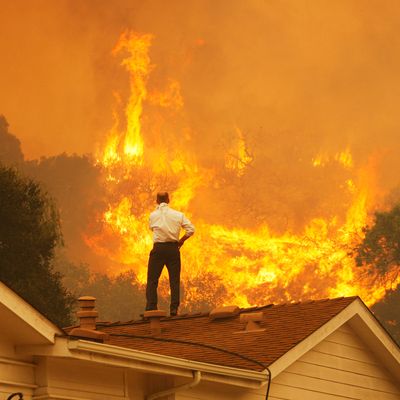
Some six months after the Intergovernmental Panel on Climate Change released its “code red” climate report comes a new and damning follow-up assessment of the impact global warming will have on daily life. Call it the “Your House Is on Fire” report, one scientist suggested to the Associated Press, or “an atlas of human suffering,” as United Nations secretary-general António Guterres put it. Either way, the forecast is (once again) bleak: Warming is outpacing the world’s capacity to adapt to the conditions outlined in August’s report. And without immediate, drastic, and truly global reductions in emissions, the hurdles of a hostile environment may become insurmountable for people in vulnerable areas.
The IPCC’s latest report looks at the science behind the climate crisis and attempts to chart a timeline for the worst possible outcomes, concluding that we are very nearly out of time to avert the worst-case scenario. Without unprecedented, transformational intervention, the world would likely exceed the climatic tipping point — 1.5 degrees Celsius of atmospheric warming — within the next ten years, cementing extreme weather events, withering droughts, and destructive rises in sea levels as the norm. Monday’s report (from 270 researchers across 67 countries) takes a granular view of what life on an increasingly uninhabitable planet will look like. It warns that the scope of the problem could exceed adaptation efforts, particularly in developing nations that have contributed the least to overall warming.
Already, wildfire seasons on North America’s West Coast seem to worsen every season, taking lives, destroying homes, incinerating farmland, and sometimes triggering separate weather catastrophes. According to the report, storms, floods, and other environmental emergencies drove 13 million people from their homes in Asia and Africa in 2019. Escalating droughts and rising temperatures threaten to worsen existing food shortages. The population living with the threat of severe coastal flooding could expand by 20 percent if protections aren’t put in place. If we reach two degrees Celsius of warming, drought could fuel routine water scarcity for between 800 million and 3 billion people, while three degrees could mean five times the global risk of extreme weather, all of which would lead to death, disease, and mass displacement.
The climate crisis is affecting pretty much every area of the globe — see: wildfires in the Arctic; colossal floods in Germany; a super-cyclone followed by a monsoon in Bangladesh — but across the board, the report warns that implications for developing nations will be far worse than for wealthy countries. Meanwhile, within wealthy nations, the report predicts that it will continue to be the poor, the old, and the sick who suffer the most. “People with the fewest resources, those least responsible for the climate crisis, bear the brunt of climate impacts,” Ani Dasgupta, the president of the World Resources Institute, told the New York Times. “If you don’t live in a hot spot, imagine instead a roof blown away, a village well overwhelmed by salt water, a failed crop, a job lost, a meal skipped — all at once, again and again.”
That prognosis should not be surprising: The global North has produced the overwhelming majority of the world’s greenhouse-gas emissions with G20 nations responsible for 80 percent of that total. If this is an “unequivocally” manmade disaster, as August’s report made clear, then it is also a crisis of entrenched inequality. But as the Times notes, the annual $100 billion in climate aid that wealthier countries once pledged to developing nations has continually fallen short to the tune of tens of billions of dollars every year. At the U.N. Climate Summit in November, Gaston Browne, the prime minister of Antigua and Barbuda, pointed out that even as these countries renege on their promises, they continue to pour money (as much as $3.3 trillion since 2015) into fossil fuel.
Right now, two to three degrees of warming looks like the most likely outcome, at least according to Climate Action Tracker. To stay under 1.5 degrees, the world would have to cut carbon emissions 100 percent by 2050, a goal that currently feels untethered to reality. And yet the report suggests solutions, emphasizing the need for “transformative changes in our behavior and infrastructure” rather than a reliance on continual adaptation. If we know that coastal flooding is going to bring escalating devastation in coming years, for example, it doesn’t make sense to develop those areas; instead, it would be wise to focus on shoring up inland infrastructure and strengthening access to the resources people need — food, medicine, water — in a crisis. In other words, it’s still possible to make preparations for the future we know is coming.
Reading these warnings every couple of months and watching politicians shoot ambitious climate policy dead in the water, it’s hard not to wonder how much evidence would finally catalyze the radical change that’s called for — and how irreversibly bad things will have become, how high the cost we’ll have paid, if we get there. Speaking to the AP, experts offered a reminder about hope: “If you’re afraid of something, then you hide away, you shy away, you run away,” German vice-chancellor and minister for economy and climate Robert Habeck said. “If you hope for something, then you can find some motivation, power and energy in yourself.” The house is on fire, but get out the hoses immediately and some things can still be saved. For now, at least — but that won’t be the case forever.


